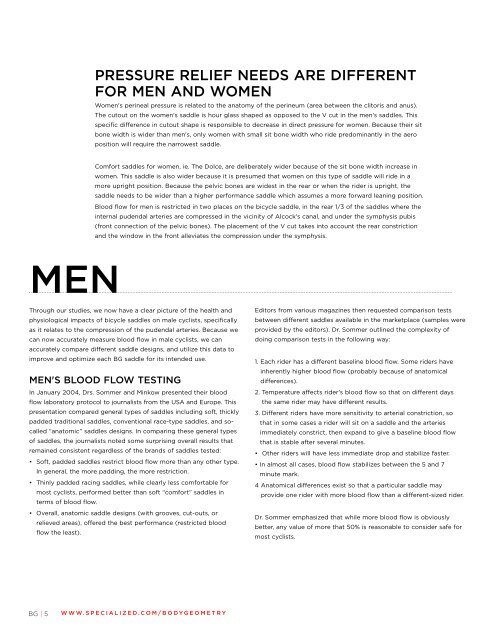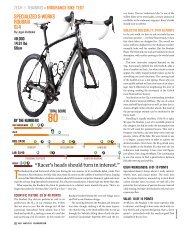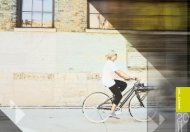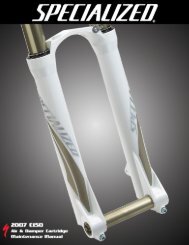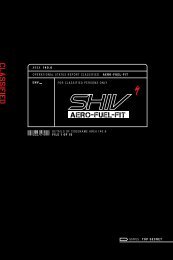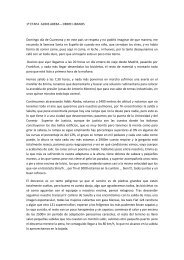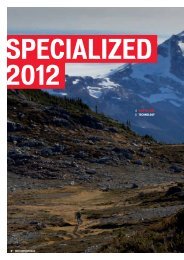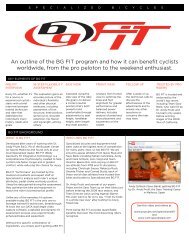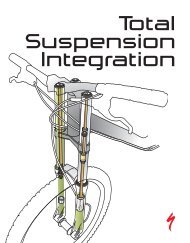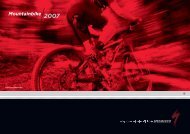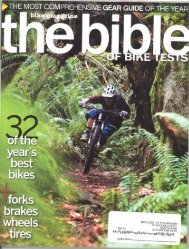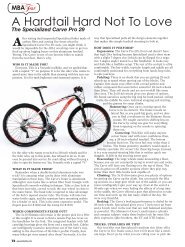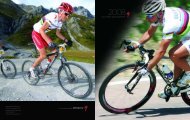Body Geometry products are scientifically developed ... - Specialized
Body Geometry products are scientifically developed ... - Specialized
Body Geometry products are scientifically developed ... - Specialized
Create successful ePaper yourself
Turn your PDF publications into a flip-book with our unique Google optimized e-Paper software.
MEN<br />
Through our studies, we now have a clear picture of the health and<br />
physiological impacts of bicycle saddles on male cyclists, specifically<br />
as it relates to the compression of the pudendal arteries. Because we<br />
can now accurately measure blood flow in male cyclists, we can<br />
accurately comp<strong>are</strong> different saddle designs, and utilize this data to<br />
improve and optimize each BG saddle for its intended use.<br />
MEN'S BLOOD FLOW TESTING<br />
In January 2004, Drs. Sommer and Minkow presented their blood<br />
flow laboratory protocol to journalists from the USA and Europe. This<br />
presentation comp<strong>are</strong>d general types of saddles including soft, thickly<br />
padded traditional saddles, conventional race-type saddles, and socalled<br />
“anatomic” saddles designs. In comparing these general types<br />
of saddles, the journalists noted some surprising overall results that<br />
remained consistent regardless of the brands of saddles tested:<br />
• Soft, padded saddles restrict blood flow more than any other type.<br />
In general, the more padding, the more restriction.<br />
• Thinly padded racing saddles, while clearly less comfortable for<br />
most cyclists, performed better than soft “comfort” saddles in<br />
terms of blood flow.<br />
• Overall, anatomic saddle designs (with grooves, cut-outs, or<br />
relieved <strong>are</strong>as), offered the best performance (restricted blood<br />
flow the least).<br />
BG | 5<br />
PRESSURE RELIEF NEEDS ARE DIFFERENT<br />
FOR MEN AND WOMEN<br />
Women's perineal pressure is related to the anatomy of the perineum (<strong>are</strong>a between the clitoris and anus).<br />
The cutout on the women's saddle is hour glass shaped as opposed to the V cut in the men's saddles. This<br />
specific difference in cutout shape is responsible to decrease in direct pressure for women. Because their sit<br />
bone width is wider than men's, only women with small sit bone width who ride predominantly in the aero<br />
position will require the narrowest saddle.<br />
Comfort saddles for women, ie. The Dolce, <strong>are</strong> deliberately wider because of the sit bone width increase in<br />
women. This saddle is also wider because it is presumed that women on this type of saddle will ride in a<br />
more upright position. Because the pelvic bones <strong>are</strong> widest in the rear or when the rider is upright, the<br />
saddle needs to be wider than a higher performance saddle which assumes a more forward leaning position.<br />
Blood flow for men is restricted in two places on the bicycle saddle, in the rear 1/3 of the saddles where the<br />
internal pudendal arteries <strong>are</strong> compressed in the vicinity of Alcock's canal, and under the symphysis pubis<br />
(front connection of the pelvic bones). The placement of the V cut takes into account the rear constriction<br />
and the window in the front alleviates the compression under the symphysis.<br />
WWW.SPECIALIZED.COM/BODYGEOMETRY<br />
Editors from various magazines then requested comparison tests<br />
between different saddles available in the marketplace (samples were<br />
provided by the editors). Dr. Sommer outlined the complexity of<br />
doing comparison tests in the following way:<br />
1. Each rider has a different baseline blood flow. Some riders have<br />
inherently higher blood flow (probably because of anatomical<br />
differences).<br />
2. Temperature affects rider's blood flow so that on different days<br />
the same rider may have different results.<br />
3. Different riders have more sensitivity to arterial constriction, so<br />
that in some cases a rider will sit on a saddle and the arteries<br />
immediately constrict, then expand to give a baseline blood flow<br />
that is stable after several minutes.<br />
• Other riders will have less immediate drop and stabilize faster.<br />
• In almost all cases, blood flow stabilizes between the 5 and 7<br />
minute mark.<br />
4 Anatomical differences exist so that a particular saddle may<br />
provide one rider with more blood flow than a different-sized rider.<br />
Dr. Sommer emphasized that while more blood flow is obviously<br />
better, any value of more that 50% is reasonable to consider safe for<br />
most cyclists.


